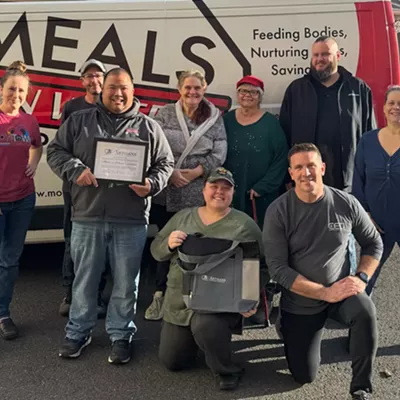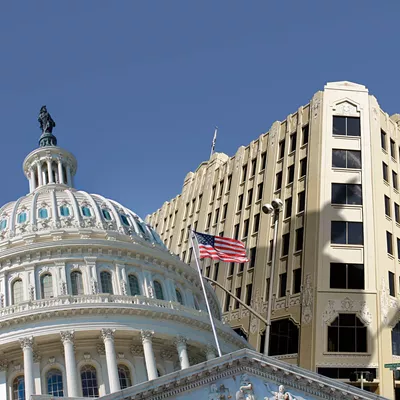Last year, when she was a second-year resident at Kootenai Health in Coeur d'Alene, Hollie Mills made it through her marathon 24-hour shifts without any coffee.
"There are residents in my programs that do drink, like, 20 cups of a coffee a day," Mills says. "That is not me."
There were some nights that she managed to total as many as six hours of sleep in the call room, broken up during slower periods. But other nights, busier nights, she didn't get a wink of sleep.
"It's tiring," Mills says. "Sometimes you don't feel like you're thinking clearly."
It's an experience nearly every resident is familiar with: Fatigue sets in during shifts that can last 24 hours — or even longer.
This issue is why, back in 2011, the Accreditation Council for Graduate Medical Education set a hard-and-fast national rule: First-year residents could only work a maximum 16-hour shift. It was an attempt to avoid the sort of mistakes that relatively inexperienced, exhausted, bleary-eyed residents could make.
But now the group has reversed itself, concluding the 16-hour cap "may not have had an incremental benefit in patient safety, and that there might be significant negative impacts to the quality of physician education and professional development."
Starting in July, patients nationwide may start being treated by first-year medical residents who've been awake for up to 24 hours. In some cases, the rule allows residents to work even longer, including a four-hour "transition" time depending on patient needs.
To some doctors and residents, it's a welcome change, recognition that one size doesn't work for all students. To others, it's a dangerous step that could lead to more patient mistakes.
LONG SHIFT
In April, Josephine Valenzuela, an emergency medicine resident in San Francisco, penned an article for the Center for Health Journalism describing how, exhausted by a series of marathon shifts, she sliced her finger on a bloody scalpel previously used on a patient with HIV, had an emotional breakdown, and then backed her car into a concrete pole.
She pointed to a study that found that being awake for 24 straight hours was equivalent to having a blood-alcohol level of 0.1 percent.
"Exhausted, backs aching, gulping down coffee, we continue to report for 28-hour shifts. And starting in June, we will be joined by the new intern class, who will have graduated medical school just weeks earlier," Valenzuela warned. "It doesn't take a doctor to understand that this isn't safe for anyone."
Mills is more in the middle. She says she knows how the lack of sleep can affect her, but also knows how to adapt. When she's feeling tired, she brings in other staff to make sure she isn't making a mistake.
"I would call my attending [physician], for something that I maybe typically wouldn't have a question on. A dose on the medication. Or ordering a medicine," Mills says. "I'd double-check it."
She sees the downsides to shorter shifts as well: "When there are too many handoffs, there are errors in patient care."
The crucial nuances of a patient's issues can be hard to summarize in writing, or even in a face-to-face conversation. And even if only small things get missed or lost in translation? In medicine, small things can matter a great deal.
But while she supports long shifts for second and third-year residents, she's concerned about whether first-year residents will have the experience to cope with 24-hour shifts while simultaneously learning the ropes of a new residency.
"You don't know how to run the computer system," Mills says about the first-year experience. "You don't even know where the bathroom is."
BALANCING ACT
Asked about the benefits and drawbacks for long shifts for residents, John McCarthy, president of the Spokane County Medical Society, says it depends on the context.
"Is it a good decision to have your speed limit be 35, or should it be 70?" says McCarthy. "It depends on where you are."
For some specialities, like obstetrics and certain types of surgery, long shifts can be particularly crucial for education purposes.
McCarthy also has concerns about the mistakes that happen with physician turnover. He also knows that, if doctors don't get a chance to get a little bit of shut-eye, "nobody can be on their game the whole time for 24 hours. I don't think that's physically possible. There needs to be a down time."
He says the danger is that, traditionally, there's been a culture at hospitals of pushing through fatigue, even when it's not a good idea. It's the kind of mentality most common among surgeons, he says.
"We're a bunch of macho guys, so everybody should have to put up with the crap we have to put up with," McCarthy says. "That's a not a good approach to medicine."
Mills and Andrea May, a third-year resident at Family Medicine Spokane, say that their residency programs make accommodations to ensure that both residents and patients are protected.
"Most frequently, you get to sleep for at least two hours," says May. "You get tired. But not to a point of exhaustion."
Both residents say that if they're so tired they're struggling to function, they can request the night off. Sometimes, May says, their colleagues will notice a resident's struggle and say, "You don't look good and you should go home."
But mostly, the residents know they need to get used to handling fatigue. The long shifts and late nights don't end when their residency does.
"I would say, and most of my colleagues would say, that they work harder in practice than they worked as a resident," McCarthy says. ♦
RESIDENTIAL DEVELOPMENT
Spokane County Medical Society President John McCarthy has a single word to sum up how Spokane has done when it comes to meeting the need for residency slots to train doctors. "Poorly," he says.
With the addition of WSU's Elson S. Floyd College of Medicine, and the flood of new Spokane medical students from the University of Washington, the city has taken the first steps to addressing the low numbers of doctors in Eastern Washington.
But the bigger bottleneck is the number of residency slots. Historical practices have meant that East Coast hospitals get significant amounts of federal resources for residency slots, while hospitals on the West Coast get very few.
Slowly, Spokane is addressing the issue. Last fall, the Spokane Teaching Health Clinic opened; six new residents will graduate from there at the end of this year.
"Now we have 18 additional residents in the pipeline," says Nancy Vorhees, executive director of the Spokane Teaching Health Center, a consortium of Washington State University Health Sciences Spokane, Providence Health Care and the Empire Health Foundation. "If you go to a residency in a community, there's a really good chance you'll stay in the community. We really think it's going to make a huge difference."
But it's still just a drop in the bucket when it comes to the overall need, says McCarthy.
"We've moved from about 70 to 90 [residents] because of this," he says. "We did a study that says we should probably have 300 to 350 residents."
One of the best signs for the future, McCarthy says, is the fact that MultiCare Health System, a nonprofit based in Tacoma, bought Deaconess and the rest of the local Rockwood Health System from Community Health Systems. MultiCare, unlike CHS, has a strong track record of investing in residencies.
— DANIEL WALTERS






















